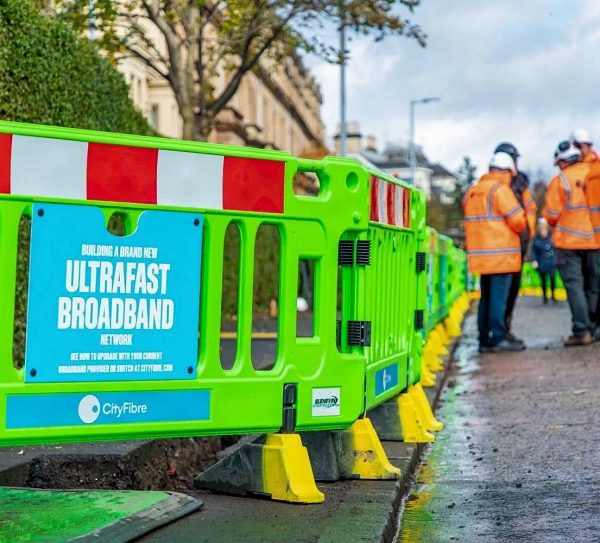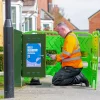CityFibre Expands Full Fibre Broadband to 2.5 Million UK Premises

Network operator CityFibre has announced that their gigabit-capable full fibre (FTTP) broadband ISP network now covers 2.5 million UK premises (up from 2m in September 2022) and 2.2 million of those are considered to be ‘Ready For Service’ (up from 1.8m), which means that residents can place an order with one of their 36 ISPs (up from 30).
All of this forms part of Cityfibre’s wider effort to cover up to 8 million premises (funded by c.£2.4bn in equity and c.£4.9bn debt) – across over 285 cities, towns and villages (c.30% of the UK) – by the end of 2025 (here). Once completed, this is expected to include coverage for over 800k businesses, 400k public sector sites and 250k 5G access points too. The operator also intends to grow into rural areas via the £5bn Project Gigabit rollout.
Just to be clear, the 300,000 difference between the build total of 2.5m and the RFS total of 2.2m reflects locations where CityFibre says their network has been built, but ISPs have yet to adopt it; there’s usually a time lag between going live and ensuring ISPs can deliver to those same areas.
Advertisement
Overall, Cityfibre said their network footprint increased by 83% in 2022, with rollout now underway in 75 metropolitan areas. In the second half of 2022, it claims to have achieved an average run rate of 22,000 premises passed per week, “reflecting a major increase in network construction” (indeed, since around mid-2022, they’ve generally been adding about 100k premises every month).
The network also added 115,000 new residential broadband customers to its network in the year, which brings their total to over 175,000 – almost doubling the rate of the previous year. This reflects a take-up of around 7%, which is low but not too unusual for a network that is still in the rapid ramp-up phase of build. But it would have been nice to get some figures for business FTTP customers too.
The operator said this meant their penetration rate is “on target across all locations,” with “mature networks” (examples below) said to now be exceeding the much higher figure of 27% in some locations. As we always say, in order to correctly judge take-up, you have to wait a couple of years post-deployment in order to allow time for awareness to rise and organic growth among consumers etc.
On average, CityFibre’s mature networks are said to be increasing their take-up by about 1% per month. In Stirling, for example, penetration has exceeded 23% and in Milton Keynes, its most mature network footprint, penetration has now passed 27%.
Advertisement
Greg Mesch, Chief Executive Officer at CityFibre, said:
“We’re delighted at the huge progress we’ve made over the course of last year. We now have a fully financed rollout, fully mobilised supply chain and an established portfolio of onboarded ISP partners. After years of constant scaling, we are now entering a new phase of our development where we can focus on efficiencies and optimising our operations at scale.”
CityFibre has done a good job of slowly, but methodically, turning itself into the UK’s third major gigabit-broadband infrastructure provider, after Openreach and Virgin Media, although they still face many challenges. One of the problems is with Openreach’s recently proposed FTTP price cuts (here), which threaten their own wholesale products. But that is itself a reflection of the fact that alternative networks (AltNets) in general are being even more aggressive on FTTP price.
The operator is also busy upgrading its older GPON network to harness 10Gbps capable XGS-PON technology (here and here). This is important because, as the UK’s full fibre market starts to mature, we’d expect a rush of providers to launch even faster multi-gigabit broadband packages, whether you need them or not. Some have already done this (e.g. B4RN, CommunityFibre and Zzoomm), but others will soon follow.
For example, Openreach are currently conducting pilots of a new FTTP tier that offers speeds of 1.8Gbps, while Virgin Media has conducted several trials of a 2.2Gbps connection. As full fibre coverage grows, then differences in speed will once again become more of a marketing point to help drive sales.
Mark is a professional technology writer, IT consultant and computer engineer from Dorset (England), he also founded ISPreview in 1999 and enjoys analysing the latest telecoms and broadband developments. Find me on X (Twitter), Mastodon, Facebook, BlueSky, Threads.net and Linkedin.
« Shell Energy Ponders Exit from the UK Broadband ISP Market























































Does this include premises covered by Toob?
I suspect not as they’ve been adding c.100,000 premises a month since before toob and that agreement is very recent. But I will ask.
Toob is NOT included in the figures. Confirmed.
2.5 million UK premises are ready for service which of 300k are actual customers. 2.2 million are either not interested/don’t need it, are on long term contracts with different ISPs or have better offer from competitors? Thats a lot and if my thinking is right then it is a bit concerning from CF investors point of view. What is the profitability threshold and is there a massive discount ahead of us in the next few years or rather market consolidation?
thats not excactly how it works, what you have just said is bascially expecting around 2 million people have switched over to Cityfibre almost imediatly after build has been completed in that area.
it takes time for people to be educated on what is available in the area and most of the normal public only check when they are close to their contract being up.
Also most Broadband search engines when entering your postcode do not show Altnets they only show Openreach and Virgin media based products, to top it off 65% of the UK think they already have full fibre due to years of missleading advertising.
How is this concerning? 27% in a mature network is superb. They method of deployment isn’t the best user experience (e.g. not available for a while after the works complete, limited ISP choice after this delay)
Your figures are also out, as 2.5m is network available.
it should be 2.2million and 1.9million.
Whilst that’s still a big scary number – it’s not in the grand scheme of things as the newer networks will build up slowly. ISPs will have to letter drop / advertise – get people who are out of contract etc.
No, I am not expecting 2 millions of people to switch immediately but 300k is a bit small number. However we will see what will happen in next 4-5 years when most or all altnets finish their build phase..
Not the right way to look at it as other commentators have stated. Only 12-18% of people change broadband provider in any given year. City fibre are taking 50% plus share of available switchers which is a very high success rate.
Got a lot of city fibre in my area and due to the mess and trouble they have caused with property and the state of the streets the local neighbourhood have just said they wont be moving onto their network as a consequence
That’s their loss then, im fully behind quality work and health and safety.
But people seem to think that installing a brand new network is somehow going to magically appear, it isn’t going to float to your house on a cloud.
Yorkshire Water and other utility companies are as bad if not worse but people say o its yorkshire water, water is important so turn a blind eye.
CityFibre have been working on their Reading (and surrounding areas) rollout for years, and it seems to move at a glacial pace. I realise it’s a massive undertaking, but it’s still frustrating to have it constantly advertised as being available when they are still busy digging up the roads and running fibre. Nonetheless, I cannot wait to ditch BT line rental and move to a cheaper, faster product when they are finally done. Some kind of rough but realistic estimate of when that will be would also be nice.